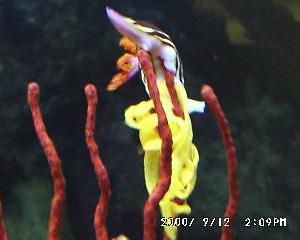Nembrotha rutilans in aquarium
September 19, 2000
From: Jeremy Rose

Note added 4 March 2008: Following Pola et al (2008) the name N. rutilans has been replaced by Nembrotha purpureolineata [see message #21419].
I came across David & Leanne's posting.
Interestingly enough I have just purchased a N. rutilans from a local marine shop here in London, UK. It was so amazing I just had to get it for my reef tank.
Because of the posting (and others) I have been able to identify the species.
Some things happened
10th September Placed in the tank
11th September Chevron Tang and Sweet Lips died (I don't know if there is any connection)
12th September it climbed up a red Gorgonia and laid a yellow tissue like ribbon. I had no idea what was happening although I thought it might be laying. Your posting clarified this. Yellow Tang had a little taster of the ribbon.
13th September both ribbon and N. rutilans are still up the Gorgonia.
Questions:
Is it poisonous?
What happens to the ribbon - do little ones hatch from it? If so, how long does it take and what should I do?
Jeremy Rose
jerry@photobase.co.uk


Dear Jeremy,
Is your Nembrotha poisonous to your fish? Did it kill them? I'm not sure. Many nudibranchs have nasty chemicals in their skins for defence. These are usually obtained from their food, either directly or as a molecule which they can easily alter. Ascidians (sea squirts, tunicates), which species of Nembrotha eat, do have defensive chemicals, and species of Nembrotha do produce secretions from their skin. So it is possible that they could have killed you fish, but I don't know of any experimental observations to show that they can. Certainly species of Phyllidia and related genera are not good company in an aquaria, because they do produce toxic secretions.
As you say, the ribbon is an egg ribbon. Often nudibranchs when they are stressed, lay an egg-ribbon almost as though they know they might not have long to survive and should attempt to perpetuate their species. If the eggs are fertile they will produce tiny free-swimming veliger larvae, which without a lot of care will almost certainly not survive aquarium life.
The other bad news is that most nudibranchs have very specialised diets. In the case of species of Nembrotha, each species eats one, or a few, species of ascidian. Even if you could buy the specific species of ascidian, the chances of keeping it alive in your aquarium as food for your Nembrotha are very slight.
Best wishes,
Bill Rudman.
Related messages
-
Nembrotha purpureolineata and caprellids
From: Valda Fraser, February 17, 2009 -
Abnormality in Nembrotha purpureolineata
From: Leanne & David Atkinson, March 26, 2008 -
Nembrotha purpureolineata laying eggs
From: Leanne & David Atkinson, March 4, 2008 -
Nembrotha rutilans mating in Raja Ampat
From: Bob Whorton, June 5, 2007 -
Nembrotha rutilans? from Indonesia
From: Aaron Fink, March 5, 2007 -
Nembrotha rutilans mating from Lembeh Strait
From: Mike Krampf, December 5, 2006 -
Nembrotha rutilans - feeding observations
From: L. & D. Atkinson, February 15, 2006 -
Nembrotha purpureolineata or purpureolineolata?
From: Roberto Sozzani, February 10, 2006 -
Nembrotha rutilans - colour variation
From: Bruce Potter, February 8, 2006 -
Nembrotha rutilans laying eggs
From: Leanne & David Atkinson, February 6, 2006 -
Nembrotha rutilans laying eggs - some more details
From: Roberto Sozzani, June 24, 2005 -
Nembrotha rutilans eating tunicate
From: Bob Whorton, June 9, 2005 -
Re: Nembrotha rutilans mating
From: Roberto Sozzani, May 11, 2005 -
Nembrotha rutilans mating
From: Roberto Sozzani, May 5, 2005 -
Nembrotha rutilans mating
From: Dana Africa, January 30, 2004 -
Nembrotha rutilans on the Great Barrier Reef
From: Paul Osmond, January 8, 2004 -
Nembrotha rutilans from Bali?
From: Jukka-Pekka Salmenkaita, August 29, 2003 -
re: Nembrotha rutilans at Fly Point
From: Dave Harasti, April 25, 2003 -
Nembrotha rutilans from Nelson Bay, Australia
From: Dave Harasti, April 19, 2003 -
Nembrotha rutilans from Sydney
From: Paul Selwood, January 24, 2003 -
Nembrotha rutilans juvenile feeding
From: Danny Van Belle, January 17, 2003 -
Nembrotha rutilans from Nelson Bay
From: Allan Saben, January 15, 2003 -
Nembrotha rutilans from Borneo
From: Mark Burnett, December 31, 2002 -
Nembrotha rutilans feeding
From: Sabine Noack, November 1, 2002 -
Juvenile? Nembrotha from North Sulawesi
From: Marli Wakeling, October 6, 2002 -
Nembrotha rutilans? from Malaysia
From: Richard Houghton, September 16, 2002 -
Nembrotha rutilans feeding
From: Mary Jane Adams, May 11, 2002 -
Nembrotha rutilans feeding
From: Mary Jane Adams , September 20, 2001 -
Nembrotha rutilans from Mozambique
From: Valda Fraser, May 4, 2001 -
Re: Nembrotha rutilans
From: Jeremy Rose, September 23, 2000 -
Nembrotha rutilans from Sydney
From: A. Lumnitzer & D. Piotrowska, September 21, 2000 -
Nembrotha rutilans feeding
From: David & Leanne Atkinson, January 22, 2000 -
Nembrotha rutilans from Port Stephens
From: Grey McNeil, July 14, 1999 -
Nembrotha rutilans
From: Bill Rudman, July 2, 1999 -
Nembrotha rutilans mating
From: David & Leanne Atkinson, April 15, 1999
